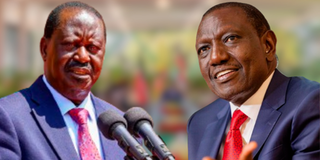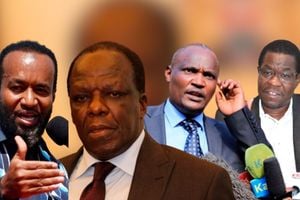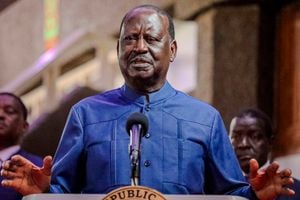
Orange Democratic Movement leader Raila Odinga (left) and President William Ruto.
The unprecedented move by ODM leader Raila Odinga’s lieutenants to join his political archrival President William Ruto’s government is the fourth time the former premier has wormed his way into a ruling regime after a crushing defeat in a general election.
The latest development – which mirrors similar moves after the 1997, 2007 and 2017 elections – continues the Azimio leader’s long history of political reinvention, exposing his ability to confound both friends and foes.
From the 2002 ‘co-operation’, 2008 ‘coalition government’, 2018 ‘handshake’ to this year’s ‘broad-based’ government; Mr Odinga has been a man so far yet not so away from the centre of power, whether through the backdoor or otherwise, always managing to enter into some loose arrangement with the government of the day.
In the run-up to the 2002 elections, Mr Odinga formally struck a political deal with the unpopular government of President Daniel Moi at a time when the country was clamouring for change of leadership after more than two decades of the reign of the third president.
Coalition government
Mr Odinga would also find himself working again with the government of the day in a coalition government after the hotly contested 2007 election.
In 2018, the former premier would enter into a “handshake” with President Uhuru Kenyatta after losing the 2017 election and subsequently swearing himself as the “People’s President”.
After suffering a painful defeat at the hands of President Ruto in the August 2022 presidential election during his fifth stab at the presidency, losing by a 200,000 margin despite being backed by the incumbent, many had predicted the political end of a man who has been hailed as the enigma of Kenyan politics.
Frequent attacks on the Kenya Kwanza regime will follow after the hotly contested election with the former Lang’ata MP taking on his political friend-turned foe, Dr Ruto, over the high cost of living and runaway taxes.
The attacks would slow down as the ruling regime offered an olive branch birthing bipartisan talks, which would later morph into a national dialogue committee resulting in a cordial relationship between the two top leaders.
However, the opposition leader denied having any working arrangement with the President, saying he is not after another ‘handshake’.
But with the President facing unprecedented pressure from the youth with anti-government protests rocking the country, the two leaders began to close ranks.
While firing his Cabinet early in the month, the Head of State mooted the behind-the-scenes happenings, revealing his intent to set up a broad-based government after extensive consultations with different stakeholders in the country, including political leaders.
Less than two weeks later, President Ruto announced the incorporation of four top leaders from Mr Odinga’s ODM party to be part of his new-look Cabinet, pending approval by Parliament.
The four include John Mbadi, former Mombasa governor and ODM deputy party leader Hassan Joho, ODM Director of Political Affairs Opiyo Wandayi and former Kakamega governor and ODM deputy party leader Wycliffe Oparanya.
In the deal, the four have been nominated to powerful dockets in the government with Mr Mbadi proposed as the next National Treasury and Economic Planning minister, Mr Wandayi (Energy), Mr Joho (Mining and Blue Economy) and Mr Oparanya (Cooperatives and MSMEs).
“I commend the leadership of diverse organisations, both in the public and private sectors, including political parties, for their encouraging response to my outreach to consult on forming a broad-based government,” said President Ruto.
“Their willingness to set aside partisan positions and interests in order to join a visionary partnership for the radical transformation of Kenya is a historic gesture of their patriotism,” he added.
The development was a stark departure from a statement released by ODM secretary-general Edwin Sifuna just a day earlier, unequivocally declaring the party is not in negotiations with the Ruto regime for any coalition or political arrangement.
Mr Sifuna said the party’s position on the proposed broad-based dialogue and eventual formation of an all-inclusive government should not be misconstrued to mean a clean bill of health for the Kenya Kwanza government.
“A narrative has been woven that ODM is desperate to join the government when all along we have been clear that what we seek is a national conversation preceded by the creation of the necessary environment through the implementation of our demands,” said Mr Sifuna.
ODM gave a list of demands that had to be fulfilled before a formal engagement with the government would be entertained.
The conditions included compensation for protest victims, release of protesters from police custody, dropping of protest-related cases, prosecution of protest killer cops, and sacking of Nairobi Region Police Commander Adamson Bungei.
Interestingly, days before the Wednesday announcement, Mr Odinga had given hints on what was in the offing.
The ODM leader, speaking during his party’s joint national executive committee and parliamentary group meeting, appeared to back Dr Ruto’s regime questioning the push by Gen Z to have the President resign, terming “dire” consequences of such a move.
“Ruto goes, then what? Ruto may go, then Rigathi Gachagua takes over, still implementing bad policies. Ruto can also say I am tired, let the generals (military) take over…. Ruto must go, there cannot be an end,” said Mr Odinga.
“It is at times of crisis like this that a country needs to talk. We are not doing it to save Ruto. We are doing it to save Kenya…,” he added.
Fashioning himself as a risk taker, the former prime minister has branded himself as a politician not afraid to risk his support base to join the government.
In 2018, Mr Odinga brokered a political truce with President Kenyatta less than eight months into a government he had questioned its legitimacy.
After losing to Mr Kenyatta in the controversial August 2017 election, Mr Odinga went ahead to swear himself in as the “People’s President” on January 30, 2018 in an unprecedented move at the iconic Uhuru Park.
With boycott of ordered repeat elections and deadly protests following, the ODM leader pulled a surprise both on his supporters and opponents at large.
Public handshake
At the steps of Harambee House on March 9, 2018, Mr Odinga and his arch-rival President Kenyatta engaged in a public handshake, signaling a surprise move to embrace a government they had been fighting.
The move caught the other three leaders of the opposition coalition National Super Alliance (Nasa) by surprise.
However, Mr Odinga did not look back. The two leaders would grow into bossom political friends with the political bromance resulting in Mr Kenyatta backing the Azimio leader in the 2022 elections.
This was after Mr Kenyatta had fallen out with his then deputy, Dr Ruto, after the infamous ‘handshake’.
The Azimio leader would turn out to be the government’s foremost defender on a number of issues, especially the war on corruption and the Big Four agenda.
The truce between the two resulted in joint projects, including the Building Bridges Initiative and the Azimio la Umoja-One Kenya Coalition, which Mr Odinga used to battle Dr Ruto for the presidency in 2022.
In the current scenario, President Ruto and Mr Odinga are involved in the campaign by the latter for the Africa Union Commission chairperson seat, where the President has been his chief campaigner.
“Raila Odinga is very unpredictable because when you think that he is out, he resurfaces and in most cases, he gets his closest friends by surprise,” said Prof Masibo Lumala of Moi University in an interview with the Nation in March last year.
Unity deal
In the lead-up to the 2002 election, Mr Odinga struck a unity deal with the ruling Kanu, in a loose alliance baptised ‘co-operation’, which gradually edged closer into a ‘partnership’, and then ultimately became a ‘merger’ on March 18, 2002.
Mr Odinga would find himself in the government as a powerful Energy minister with his National Development Party (NDP).
The loose coalition government also saw two MPs from Mr Odinga’s party, Peter Odoyo and Joshua Ojode, named assistant ministers for Foreign Affairs and Science and Technology, respectively, in the reshuffle.
Fast forward to 2008, Mr Odinga found himself thrust into the highest political office he has ever occupied after a political deal brokered by the late Koffi Annan gave birth to a coalition government after the disputed 2007 polls that led to post-election violence.
He would be named a prime minister where his role was to coordinate and supervise the functions of the government, as the chair of Cabinet, after the historic Handshake.
Speaking in April 2022, Mr Odinga hailed the grand coalition as the best government that Kenya ever had since independence. “It was, therefore, necessary to go beyond our personal interests and think about the country, and that is what drove me to agree that we should make a compromise,” said Mr Odinga.
“We shook hands first with them before we did it in public and we agreed that we work together to ensure that the grand coalition that we are going to form will deliver to the people of Kenya.”









